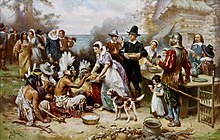Jean Leon Gerome Ferris
| Jean Leon Gerome Ferris | |
|---|---|

The First Thanksgiving 1621
|
|
| Born |
August 18, 1863 Philadelphia, Pennsylvania |
| Died | March 18, 1930 (aged 66) Philadelphia, Pennsylvania |
| Nationality | American |
| Education | Pennsylvania Academy of the Fine Arts |
| Known for | Painting |
Jean Leon Gerome Ferris (August 18, 1863 – March 18, 1930) was an American painter best known for his series of 78 scenes from American history, entitled The Pageant of a Nation, the largest series of American historical paintings by a single artist.
He was born in Philadelphia, Pennsylvania, the son of Stephen James Ferris, a portrait painter and a devotee of Jean-Léon Gérôme (after whom he was named) and Mariano Fortuny. He grew up around art, having been trained by his father and having two acclaimed painters, Edward Moran and Thomas Moran, as uncles.
Ferris enrolled in the Pennsylvania Academy of the Fine Arts in 1879 and trained further at the Académie Julian beginning in 1883 under William-Adolphe Bouguereau. He also met his namesake Jean-Léon Gérôme, who greatly influenced Ferris's decision to paint scenes from American history. As Ferris wrote in his unpublished autobiography, "[Gérôme's] axiom was that one would paint best that with which he is most familiar".
However, initially his subjects were Orientalist in nature, that movement having been in vogue when he was young. Some of his material was original, some of it took after Fortuny, but he was skilled enough, despite never having had any experience with Asia. In 1882, he exhibited a painting entitled Feeding the Ibis, which was valued at $600.
By 1895, Ferris had gained a reputation as a historical painter, and he embarked on his dream of creating a series of paintings that told a historical narrative. In 1898 he sold one of these, General Howe's Levee, 1777, but he later regretted it, realizing that such a series could not be complete if the separate paintings could not be kept together. Consequently, he never sold another one of those, but he did sell the reproduction rights to various publishing companies. This later would have the effect of greatly popularizing his work, as these companies made prints, postcards, calendars and blank-backed trade cards to use in advertisements. Laminated cards of these works were still being sold as late as 1984.
...
Wikipedia
